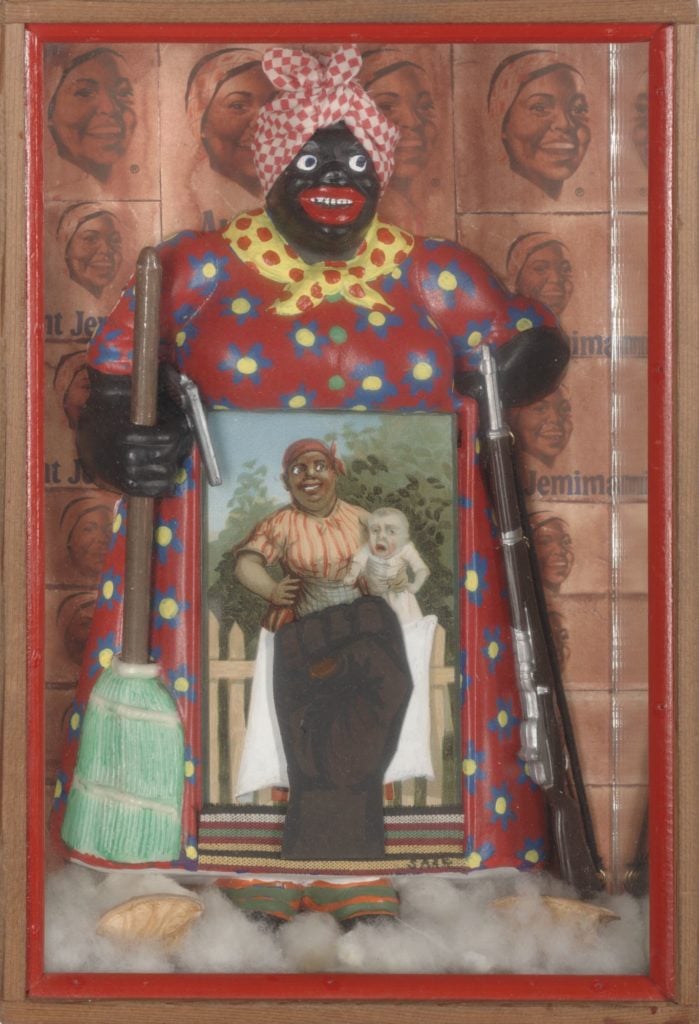Art World
The Getty Kicks Off an Ambitious New African American Art History Initiative by Acquiring Betye Saar’s Archive
The Los Angeles artist is a pioneer of assemblage art.

The Los Angeles artist is a pioneer of assemblage art.

Sarah Cascone

The Getty Research Institute in Los Angeles is launching an African American Art History Initiative, and it has acquired the archive of Betye Saar (1926–) as a first step. With an initial budget of $5 million, the initiative will make new acquisitions and develop research projects, as well as help other museums preserve and digitize their own archives. The Getty is working with the Studio Museum in Harlem, the California African American Museum, Art + Practice in Los Angeles, and Spelman College in Atlanta on the project.
“The Getty is making a strong, long-term commitment of unprecedented breadth to the field of African American art history,” said James Cuno, president and CEO of the J. Paul Getty Trust, in a statement. “The study of African American art history is fundamental to a comprehensive understanding of American art history. We aim to bring our resources, talents, and relationships together to promote advanced research in an area of American art that has been underfunded and under-researched.”
As reported recently by artnet News, African American artists continue to be under-represented and under-recognized both at auction and in museum exhibitions and acquisitions. In the last 10 years, African American artists represent a mere 2.4 percent of all acquisitions and gifts and 7.6 percent of all exhibitions at 30 prominent US museums. The Getty’s new initiative represents one way institutions are looking to rectify this imbalance through scholarship.
As reported by the New York Times, the Getty Research Institute plans to hire a curator and bibliographer with the aim of acquiring new work and developing research projects. It will also fund two postgraduate fellowships in African American art annually, and aid other institutions in their efforts to preserve, digitize, and make public archives of African American art. Kellie Jones, professor in art history and archaeology and the Institute for Research in African American Studies at New York’s Columbia University, has been hired as a senior consultant.
The acquisition of Saar’s archives is part of a growing reappraisal of her work in particular. In 2010, the artist was one of the highlights of the region-wide, Getty-funded Pacific Standard Time initiative showcasing Los Angeles art, appearing in no less than eight exhibitions. This fall, Saar figures in “Soul of a Nation: Art in the Age of Black Power” at the Brooklyn Museum (through February 3, 2019), and has a solo show at the New-York Historical Society titled “Betye Saar: Keepin’ It Clean” (November 12, 2018–May 27, 2019).

Betye Saar, Liberation of Aunt Jemima (1972). Photo by Benjamin Blackwell, courtesy of the artist and Roberts Projects, Los Angeles.
“Betye Saar is one of the most innovative and visionary artists of our era. She has also, in many ways, been the conscience of the art world for over fifty years and we are so honored that she has trusted us to preserve her powerful legacy,” said Andrew Perchuk, acting director of the Getty Research Institute, in a statement. “She played a large role in our exploration of postwar Los Angeles art that became ‘Pacific Standard Time: Art in LA 1945–1980,’ and this acquisition is a particularly meaningful way for us to launch the African American Art History Initiative.”
The Getty Research Institute’s holdings include the work of other African American artists—such as Adrian Piper, Kara Walker, Ed Bereal, Benjamin Patterson, Melvin Edwards, Lorna Simpson, Harry Drinkwater, and Mark Bradford—but the Saar archives mark the start of a new focus for the organization. The artist is known for her assemblage works, in which she combined her drawings, prints, and etchings with unconventional materials, such as leather, fur, yarn, and poker chips.
“When you’re 92, it takes a lot to get you excited. I paid my dues, and now, I’m reaping the rewards,” Saar told the Los Angeles Times. “I’m very happy that anybody can go [to the GRI] to discover my work, not just the art community. It’s my contribution.”